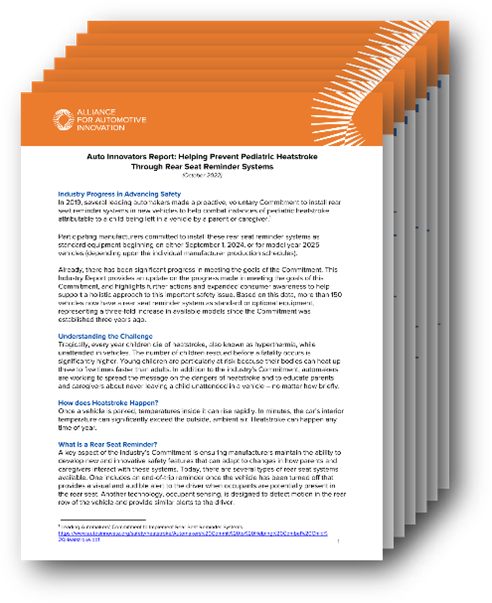Rear Seat Reminder Systems Now Available in 150+ Vehicle Models
Technology notifies caregivers when child left unattended in vehicle
Follows 2019 industry commitment to install systems in all covered vehicles by 2025; three-fold increase in three years
Public awareness, partnership with Washington Nationals additional initiatives to help save lives
WASHINGTON, DC – The Alliance for Automotive Innovation today released a new report on the auto industry’s progress toward universal rear seat reminder systems in new vehicles by 2025.
Data collected by the association indicates more than 150 vehicle models on the market today include the lifesaving rear seat reminder technology as standard or optional equipment (a three-fold increase in three years).
Rear seat reminder systems can help prevent pediatric heatstroke that occurs when a child is left unattended in a vehicle by a parent or caregiver.
John Bozzella, president and CEO of the Alliance for Automotive Innovation, said: “We know rear seat reminder technology can help save lives by alerting parents or caregivers when a child is left in the rear seat of a vehicle. This data indicates major progress toward our goal of universal rear seat reminder systems by 2025 – progress that has accelerated since our voluntary commitment to introduce the technology on all vehicles just three years ago.”
These systems include:
· An end-of-trip reminder system that provides a visual and audible alert when occupants are present in the rear seat after the vehicle is turned off;
· Occupant sensing, which works by detecting motion in the rear row of the vehicle and provides similar alerts to the driver.
Participating manufacturers signed the automotive industry’s voluntary commitment to install rear seat reminder systems in most new cars by 2025.
Read the Auto Innovators report: Helping Prevent Pediatric Heatstroke Through Rear Seat Reminder Systems.
Alliance for Automotive Innovation efforts to help prevent pediatric heatstroke, include:
· A partnership with the Washington Nationals;
· A heatstroke prevention resource page;
· A digital advertising campaign in several of the hottest states in the country; and
· A webinar with automakers and regulators about ways to prevent pediatric heatstroke.

